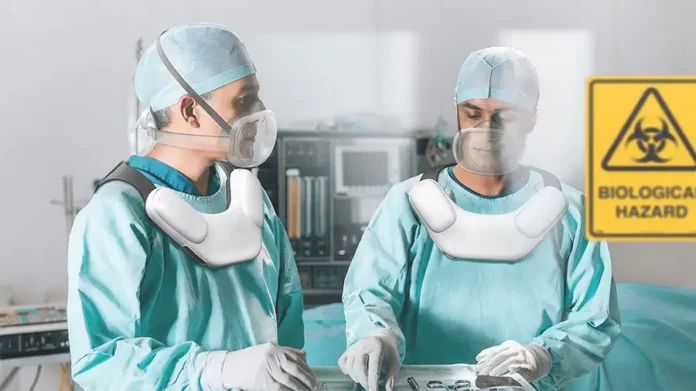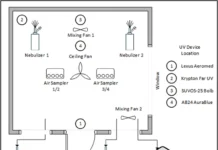By Liz Stevens, writer, UV Solutions
XCMR, Philadelphia, Pennsylvania, a 2024 IUVA Americas RadLaunch awardee, is a UV technology startup on a quest to combat airborne pathogen transmission. In the current era of pathogens, pandemics and antibacterial resistance, novel germicidal methods are sorely needed, since many of the usual methods – bulky respirators, chemical decontamination, pharmaceutical solutions and personal protective equipment (PPE), such as masks – have drawbacks. XCMR’s aim is a proactive one – to prevent pathogen spread rather than to react to pathogen spread.
XCMR, in collaboration with academic, industry and government partners, is using UV-C for air disinfection in a closed system to replace conventional respirators and outdated PPE. The company’s Near-field Infection Protection (NIP)TM technology incorporates UV-C into wearable, portable and stationary devices to disinfect incoming and outgoing airflow using photons instead of filters. The NIP inactivation mechanism is agnostic to the pathogen and XCMR’s modular UV-C reactors are said to offer performance improvements over traditional technologies.
This technology underpins the current application of XCMR’s Symmetrical Flow DisinfectionTM mask program. The company’s wearable protection components initially are designed for the military, healthcare workers and first responders. The technology features a transparent face mask, interchangeable UV-C reactor pods that incorporate a range of UV-C emitters and a hot-swappable battery. Richard Rasansky, CEO of XCMR, gave UV Solutions insight into several aspects of the design process and the resulting technology.
Targeting Pathogens
XCMR calibrates its interchangeable UV-C reactor pods to target specific pathogens. “We take into account the physiology of the organism being targeted for inactivation, the wavelengths of UV-C we can generate and where/how energy is absorbed by the pathogen,” Rasansky explained. “For example, we know DNA and RNA strongly absorb at ~250-260 nm, while proteins tend to absorb more strongly at wavelengths less than 240 nm. If we are targeting bacteria, we probably want to hit its DNA to prevent further replication. If we are targeting viruses, we’d likely want to irradiate their protein capsids that protect and transfer the genetic payload that allows them to replicate.” Rasansky acknowledged that there are exceptions to these rules, and that it is not possible to know what is most effective without doing some testing. “In general,” he said, “any UV-C wavelength will kill microorganisms at a high enough dose; we strike a balance between broad spectrum effectiveness and efficiency of photon generation.”
Design Factors
UV-C radiation can damage polymers, including plastics, insulation and gaskets. XCMR made careful design choices and chose product material that will not be meaningfully degraded by prolonged UV exposure. “Internally, our reactor pods use materials that are highly reflective to UV, primarily to increase their effectiveness,” said Rasansky. “But, because all photons are contained within the device, we do not have to concern ourselves with how UV will interact with materials outside the reactor pods.”
Another design factor revolved around considering the variability in a PPE user’s breathing rate. In a relatively static situation, such as a surgeon wearing PPE in the operating room, the breathing rate would be much slower and steadier than in a dynamic setting, like a first responder in action. “One of the major advantages of using XCMR’s UV reactor over using a filter,” Rasansky explained, “is that filters create high breathing resistance, and the unrestricted airflow of our reactors require no additional effort from the wearer as breathing rates increase. That said, as breathing rates increase, residence time of the air inside our UV reactor decreases, so additional energy is necessary to maintain the requisite UV dose for this reduced period of exposure.” XCMR was mindful of these circumstances and designed its systems around their intended use case. “A mask intended for everyday use in an office, a classroom or, say, in an airplane,” said Rasansky, “would not work for a high-intensity combat/first responder scenario, and a first responder mask would be way overbuilt for everyday use.”
Challenges in Development
Rasansky stated that the company faced many challenges in the design and rollout of its products. “One challenge that we still are working on involves human factors and ergonomics,” he explained. “Like all PPE, our masks will only work if they are used properly and can be worn comfortably. The pandemic made it quite clear that even something as intuitive as a facemask often is used improperly for a multitude of reasons. Simple, intuitive and ergonomic design is a major focus of XCMR. Thankfully, NIOSH also has identified ergonomics as a major shortcoming in mask design and is continuing to provide excellent guidelines for ergonomic respirator design.”
Another challenge was posed by the regulatory structure currently in place for respiratory PPE. “Every standard test method currently employed for approving respiratory PPE,” said Rasansky, “relies on quantifying how many particles can be removed from a system. Our products do not remove threats, they destroy them. We are working closely with regulatory stakeholders to identify appropriate test methods that do not rely solely on filtration efficacy as a performance metric.”
An “aha!” moment for XCMR occurred during the R&D phase, related to maximizing the performance characteristics of the reactor design. “When thinking about the kinetics of inactivating an aerosolized pathogen,” said Rasansky, “it occurred to us that we basically were throwing away photons that did not collide with a droplet. Anything not being absorbed by a pathogen was being absorbed by the materials within the reactor. We realized that using a reflective material would not only allow us to ‘recycle’ and ‘amplify’ generated photons, resulting in higher levels of internal irradiation required for maximum pathogen inactivation, but also to protect the interior of the reactor pod from UV induced polymer damage. The result is a device that is more efficient and effective.”
In July 2024, XCMR completed the first phase of its collaboration with renowned industrial design and experience firm, frog, during which XCMR worked hand-in-hand with the frog team to overcome engineering challenges and find innovative solutions to integrate XCMR’s complex technology into a user-friendly and ergonomic design. The company has identified applications and sectors for first use of its technology, including healthcare, military and first responders, in addition to wound/incision disinfection of surgery patients – all leveraging XCMR’s core technology. XCMR soon will widen its aperture to protect immunocompromised patients and the general population with consumer-grade implementations using XCMR’s forthcoming maskless protection technology.
For more information, visit www.xcmr.co.
The Innovation Column highlights the work of an IUVA RadLaunch awardee. Information has been provided by the manufacturer for educational purposes and has not undergone peer review.






